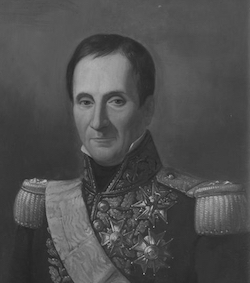Admiral Édouard-Thomas de Burgues de Missiessy

Born: April 23, 1756
Place of Birth: Toulon, Var, France
Died: March 24, 1837
Place of Death: Toulon, France
Arc de Triomphe: MISSIESSY on the north pillar
Pronunciation:
The son of a naval officer, Edouard-Thomas de Burgues de Missiessy began his naval career by serving on his father's ship starting at age ten. At age fourteen he was named a garde de la marine but only a few years later he was serving on a frigate in the Levant. In 1777 Missiessy was promoted to ensign of vessel and he served on the frigate Sultane that was tasked with protecting shipping from the Barbary pirates. The next year he was transferred to the ship Vaillant and he joined the squadron of Admiral d'Estaing. Sailing to the United States, he served at the combats of Newport, Saint Lucia, Grenada, and Savannah. In 1779 Missiessy returned to France and disembarked at Lorient, and then in 1780 he set out again, this time on the frigate Surveillante. In 1781 Missiessy received a promotion to lieutenant of vessel and he took part in a naval battle against HMS Ulysses near Saint-Domingue on June 5th. At the end of the year he returned to Brest and then in 1782 he was given command of the cutter Pygmée. This command was short-lived though, for on July 22nd of 1782 he was taken prisoner by the British before being returned to France. Missiessy continued to serve in the navy and in 1784 he was given command of the ship Guyana and sent to the Baltic Sea. The following year he was named a Knight of Saint Louis and given command of a different vessel and sent to the Windward Isles.
At the onset of the Revolution in 1789, Missiessy was commanding a frigate in the Mediterranean Sea. In 1792 he was promoted to captain of vessel and he took command of the vessel Centaure in Admiral Truguet's squadron. The next year Missiessy was promoted to rear admiral but then in May he was arrested and imprisoned as a noble at Fort Lamalgue in Toulon. When Toulon revolted against the revolutionary government in Paris, Missiessy escaped and went to live in Italy. In May of 1795 he returned to France where he was detained, however in August he was acquitted by a council of inquiry and released. Missiessy next went to Paris where he was attached to the depot of maps and plans and also assigned to the school of naval construction.
Missiessy resumed a more active command in June of 1801 when he became chief of staff of the naval force formed at Cadiz under Admiral Truguet. In 1802 he was appointed commander of the 2nd squadron of Admiral Truguet's force at Brest, and then in 1804 he was named commander-in-chief of the naval squadron based at Rochefort. While plans for the invasion of England were being carried out in 1805, Missiessy was ordered to sail for Antilles and join with the fleets of Admirals Villeneuve and Ganteaume in the hopes of attracting away some of the British fleet guarding the English Channel. He set sail and arrived in the Caribbean where he supplied Guadeloupe and lifted the siege of Santo-Domingo. Next he disembarked troops under General Lagrange at Saint Lucia and then supported operations at Dominica, Saint-Christophe, Montserrat, and Nevis. After waiting unsuccessfully for some time for Admiral Villeneuve and his fleet to arrive, Missiessy finally returned to Rochefort. Despite carrying out his orders well, after his return he was not given an active command again for a number of years.
In 1808 Missiessy was finally employed again, this time as commander of the squadron of the Scheldt based at Antwerp. In 1809 he was promoted to vice admiral and he took part in the successful defense of Antwerp from the British during the Walcheren expedition. Missiessy was named commander-in-chief of the coasts of the north in 1810 and a Count of the Empire in 1811. He continued to serve at Antwerp and in 1813 he was awarded the Grand Cross of the Order of the Reunion. Missiessy defended Antwerp again in 1814 and only gave up the defense after Napoleon's abdication and the restoration of the Bourbons. For his services to France, the restored Bourbons awarded him the Grand Cross of the Legion of Honor. When Napoleon resumed power in 1815 for the Hundred Days, Missiessy did not take part in the events.
Bibliography
Updated January 2017
© Nathan D. Jensen